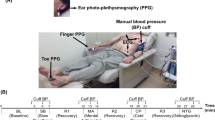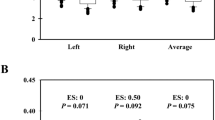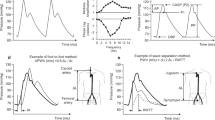Abstract
Changes in arterial distensibility have been widely used to identify the presence of cardiovascular abnormalities like hypertension. Pulse wave velocity (PWV) has shown to be related to arterial distensibility. However, the lack of suitable techniques to measure PWV nonintrusively has impeded its clinical usefulness. Pulse transit time (PTT) is a noninvasive technique derived from the principle of PWV. PTT has shown its capabilities in cardiovascular and cardiorespiratory studies in adults. However, no known study has been conducted to understand the suitability and utility of PTT to estimate PWV in children. Two computational methods to derive PWV from PTT values obtained from 23 normotensive Caucasian children (19 males, aged 5–12 years old) from their finger and toe were conducted. Furthermore, the effects of adopting different postures on the PWV derivations were investigated. Statistical analyses were performed in comparison with two previous PWV studies conducted on children. Results revealed that PWV derived from the upper limb correlated significantly (P<0.05) regardless of computing methods or postures adopted. The findings here suggest that PTT measurement can be used as a convenient and noninvasive surrogate measure of derived PWV in prolonged clinical studies, especially on younger or less cooperative children. Furthermore, the simple set-up and noninvasive nature of PTT can promote its usefulness in ambulatory monitoring.
This is a preview of subscription content, access via your institution
Access options
Subscribe to this journal
Receive 12 digital issues and online access to articles
$119.00 per year
only $9.92 per issue
Buy this article
- Purchase on Springer Link
- Instant access to full article PDF
Prices may be subject to local taxes which are calculated during checkout


Similar content being viewed by others
References
Avolio AP et al. Effects of aging on changing arterial compliance and left ventricular load in a northern Chinese urban community. Circulation 1983; 68: 50–58.
Cheung YF et al. Arterial distensibility in children and teenagers: Normal evolution and the effect of childhood vasculitis. Arch Dis Child 2002; 87: 348–351.
Senzaki H et al. Age-associated changes in arterial elastic properties in children. Eur J Pediatr 2002; 161: 547–551.
Martin H, Hu J, Gennser G, Norman M . Impaired endothelial function and increased carotid stiffness in 9-year-old children with low birthweight. Circulation 2000; 102: 2739–2744.
Lurbe J et al. Birth weight impacts on wave reflections in children and adolescents. Hypertension 2003; 41 (Part 2): 646–650.
Nolly H et al. Home blood pressure measurement: validation of the Braun BP 2550 (UG) monitor according to the ESH International Protocol. Blood Press Monit 2004; 9: 53–58.
Ng KG et al. Progress on the development of the MediWatch ambulatory blood pressure monitor and related devices. Blood Press Monit 2004; 9: 149–165.
Brands PJ et al. A noninvasive method to estimate pulse wave velocity in arteries locally by means of ultrasound. Ultrasound Med Biol 1998; 24: 1325–1335.
Wang YYL et al. Pressure pulse velocity is related to the longitudinal elastic properties of the artery. Physiol Meas 2004; 25: 1397–1403.
Smith RP, Argod J, Pepin JL, Levy PA . Pulse transit time: an appraisal of potential clinical applications. Thorax 1999; 54: 452–458.
Pitson D, Chhina N, Knijn S . Changes in pulse transit time and pulse rate as markers of arousal from sleep in normal subjects. Clin Sci 1994; 87: 269–273.
Katz ES, Lutz J, Black C, Marcus CL . Pulse transit time as a measure of arousal and respiratory effort in children with sleep-disordered breathing. Pediatr Res 2003; 53: 580–588.
Argod J, Pepin JL, Smith RP, Levy P . Comparison of esophageal pressure with pulse transit time as a measure of respiratory effort for scoring obstructive nonapneic respiratory events. Am J Respir Crit Care Med 2000; 162: 87–93.
Allen J, Murray A . Age-related changes in peripheral pulse timing characteristics at the ears, fingers and toes. J Hum Hypertens 2002; 16: 711–717.
Netea RT, Smits P, Lenders JW, Thien T . Does it matter whether blood pressure measurements are taken with subjects sitting or supine? J Hypertens 1998; 16: 263–268.
Pickering TG . Principles and techniques of blood pressure measurement. Cardiol Clin 2002; 20: 207–223.
Behrman RE, Kliegman RM, Jenson HB . Nelson Textbook of Pediatrics 2004, 17th edn. WB Saunders Company: Philadelphia, pp 1484–1488.
National high blood pressure education program working group on high blood pressure in children and adolescents. The fourth report on the diagnosis, evaluation, and treatment of high blood pressure in children and adolescents. Pediatrics 2004; 114: 555–576.
Marieb EN . Human Anatomy and Physiology 2004, 6th edn. Pearson Benjamin Cummings: San Francisco, pp 688–698.
Okada M, Kimura S, Okada M . Estimation of arterial pulse wave velocities in the frequency domain: method and clinical considerations. Med Biol Eng Comput 1986; 24: 255–260.
Nitzan M, Khanokh B, Slovik Y . The Difference in pulse transit time to the toe and finger measured by photoplethysmography. Physiol Meas 2002; 23: 85–93.
Mitchell GF et al. Changes in arterial stiffness and wave reflection with advancing age in healthy men and women. The Framingham Heart study. Hypertension 2004; 43: 1239–1245.
Rabben SI et al. An ultrasound-based method for determining pulse wave velocity in superficial arteries. J Biomech 2004; 37: 1615–1622.
Pawelczyk JA, Levine BD . Heterogeneous responses of human limbs to infused adrenergic agonists: a gravitational effect. J Appl Physiol 2002; 92: 2105–2113.
Frey MA, Tomaselli CM, Hoffler WG . Cardiovascular responses to postural changes: Differences with age for women and men. J Clin Pharmacol 1994; 34: 394–402.
Ip MSM et al. Lung function reference values in Chinese children and adolescents in Hong Kong II. Prediction equations for plethysmographic lung volumes. Am J Respir Crit Care Med 2000; 162: 430–435.
Author information
Authors and Affiliations
Corresponding author
Rights and permissions
About this article
Cite this article
Foo, J., Wilson, S., Williams, G. et al. Pulse transit time as a derived noninvasive mean to monitor arterial distensibility changes in children. J Hum Hypertens 19, 723–729 (2005). https://doi.org/10.1038/sj.jhh.1001891
Received:
Accepted:
Published:
Issue Date:
DOI: https://doi.org/10.1038/sj.jhh.1001891
Keywords
This article is cited by
-
Inferring Cerebrovascular Changes from Latencies of Systemic and Intracranial Pulses: A Model-Based Latency Subtraction Algorithm
Journal of Cerebral Blood Flow & Metabolism (2009)
-
Physiologic parameters that affect pulse transit time difference between the upper and lower limbs in children
Journal of Human Hypertension (2006)
-
Dual-Channel Photoplethysmography to Monitor Local Changes in Vascular Stiffness
Journal of Clinical Monitoring and Computing (2006)



